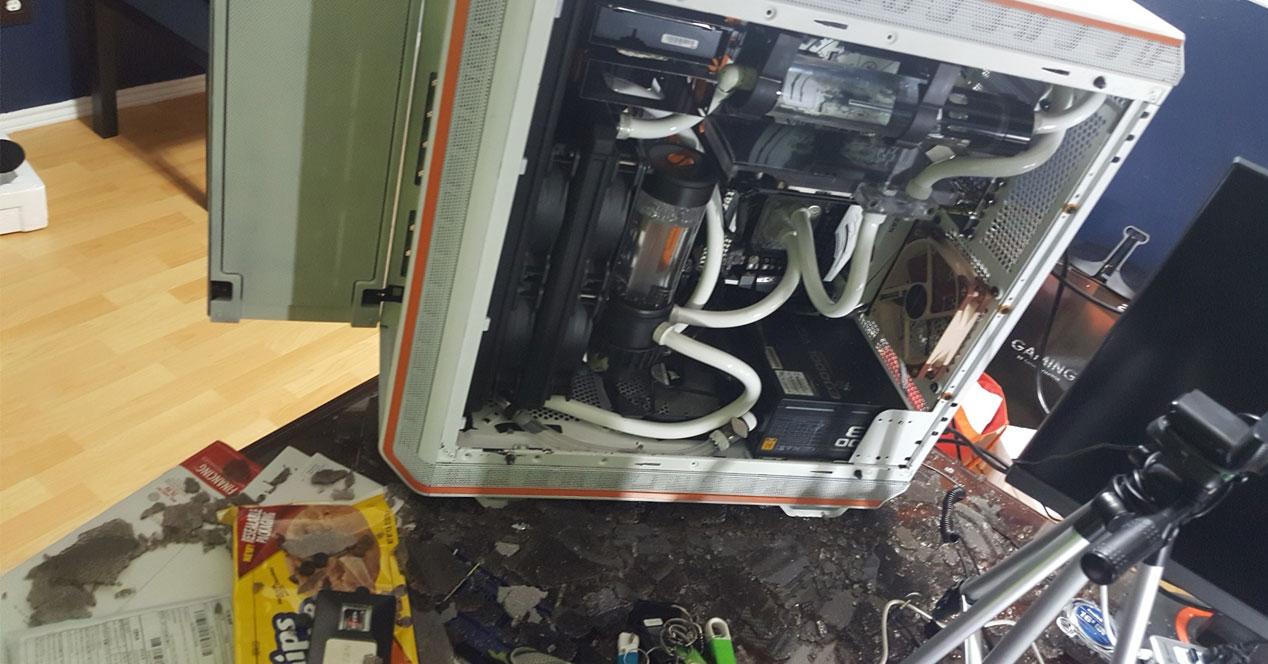- Processor
- base plate
- RAM
- Graphic card
- Storage
- Power source
We hope you find your bug and if you can’t fix it, you can at least briefly diagnose it.
What problems can the processor have
It is extremely rare for a processor to cause problems on its own. The most common is that the component causing these problems is the associated material. For example, if the processor is overheating, it may be because the heatsink is not suitable for that processor or the heatsink itself is not in contact with the IHS of the processor. But the fault, in itself, is usually not the processor.
Typically, a catastrophic CPU failure results in the system not booting. If we are sure that the rest of the Components of the system do they work correctly, then the only solution is to discard the faulty processor and replace it with a new one, compatible with the motherboard socket.
The main issues are usually operating system crashes, system slowdowns, or outright freezes. When a processor is damaged, the system normally does not boot and marks 00 in the QCode (if the motherboard has one).
The way to check if this component fails is with one or more stress tests, which could be for example RealBench, AIDA64 in FPU and Caché or Prime95 in Blend Test. We recommend the former as it is more realistic both in terms of load and oscillation of the latter, it also tests different buses that other more specific programs to extract maximum performance and CPU stress do not .
You should always monitor the CPU temperature as well as its voltage.
The most common motherboard failures
Problems with motherboards are usually due more to the VRM overheating of them, which can cause problems with stability. But it is also true that most of these problems usually occur when overclocking them. That is, under normal circumstances, temperatures tend to stay within a more or less normal range.
To check if we have a temperature problem with our motherboard, it is best to use the HWinfo program and, using Prime95 x64 (if your Windows is a 64-bit version) look at the temperatures who reach the full charge.
Other typical motherboard problems are due to improper insertion of the processor in socket where he is going, which can lead pins bend. In this case, you can always try to straighten them using a wooden toothpick or a credit card (and a lot of patience) so that they regain good contact. Otherwise, just throw the motherboard in the trash.
Another of the most common mistakes that are rarely talked about is folding or motherboard bending. This is caused by excessive pressure in the CPU retention system or excessive weight in key components such as the graphics card.
Heat and thermal cycling eventually warp the straightness of the board after months or years of use, causing small power leaks into the PCB or even the CPU not touching the socket pins with its PCB.
It’s not something fixable unless apply prolonged heat and try to straighten the plate, where anyway that guarantees nothing since the damage and breakage at the microscopic level is already done. In any case, being such a general component that includes many buses, ports and small management systems, it is very difficult to find a specific hardware failure.
RAM memory and blue screens
RAM memory can give several types of failures. The most common is that gap in slots, after doing things inside the computer, such as cleaning it. In this case, simply removing all the RAM modules and reinserting them fixes the problem.
Another thing is when one of the RAM modules suddenly stops working properly. These types of faults are displayed as instability computer constant, that the graphics card does not start when you start the computer, the files that are corrupt or incorrect information RAM quantity available on the computer.
In this case, to verify that it is indeed a RAM problem, what must be done is to recover the MemTest86
The graphics card, the problem that usually generates the most fear
The bone graphics card failure they are generally presented as not being recognized by the system when it starts. Or that performance in games drops quite unexpectedly. Or it gets too hot and causes the computer to shut down due to excessive temperatures.
If the computer is not able to detect the graphics card when booting, you can directly throw it away, unless the problem be in the Power sourcerelease.
When a descent unexpected from the performance in games this is most likely due to excessive temperatures, which causes the operating frequencies of this to drop a lot. To find out the temperature data, it is better to use the HWinfo program and a program that you can run in a loop for a long time.
In this respect and bearing in mind this material failure, the Unigine Heaven or the Unigine Valley These are perfect programs for stressing the graphics card and observing the temperatures it reaches when running. If the temperatures are very high, a good option you have is clean the sink of it and change the thermal paste you are using. If the problem is that the original heatsink has stopped working properly, you can look for a third-party heatsink to replace the original one.
The most common failure in storage units
In mechanical storage units, these types of problems can be detected by a failure of the SMART protocol which can inform us that the hard disk is not working as well as it should. We might also hear the drive giving a lot of internal knocking (“clack, clack, clack”) because the tonearm can’t be positioned correctly on the drive.
In the case of solid storage units, the first news we get of a failure will be a sharp drop in performance when storing and reading the data they contain.
In both cases, a program like the CrystalDiskInfo This can help us to a great extent, since this program is able to read the SMART protocol and inform us of possible problems with the units of our computer.
If this program detects that there are problems with one of our drives, the best thing to do is to move all the data that we have on our hard drive to another drive that does not have these problems and d stop using the problematic drive. If it turns out that the device no longer allows you to do this, you can try using the program a hard drive regenerator to get the data inside.
Power issues
To finish the list, power problems usually manifest as restart of unexpected equipment, both when the equipment is under low load and under high workload. They can also manifest themselves when certain hardware components of our computer cannot be started at startup.
In this case, it is better to use the HWinfo program to check voltage which gives each of the three main paths of the power supply: +12, +5 and +3.3 V. The tolerances of these chains come from a ±5%. If the voltages are way off the rated value they should be, the best thing to do is to remove the faulty power supply and replace it with a new one before it causes more problems.
It will not be easy to diagnose a hardware failure of this type, because for this we need a system for measuring and controlling amperage, frequencies, voltage and voltage, extremely expensive equipment , but fortunately there are devices such as tension clamps which are affordable and will allow us to see in real time what is happening cable by cable.
Additionally, many high-end motherboards have voltage test points to be measured with a multimeter. The problem is that if it is a hardware failure in the components or the PCB from the same source, we will only see the result of the failure, not where the problem is or even be able to diagnose it, because that involves a scout of values in all components of the power supply.
Table of Contents














